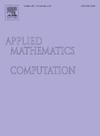Numerical simulation and error estimation of the Davey-Stewartson equations with virtual element method
IF 3.5
2区 数学
Q1 MATHEMATICS, APPLIED
引用次数: 0
Abstract
This paper aims to present the virtual element method (VEM) for solving the Davey–Stewartson equations with application in fluid mechanics. The VEM is a recent technology that can be regarded as a generalization of the standard finite element method (FEM) to general meshes without the need to integrate complex nonpolynomial functions on the elements. This method only utilizes degrees of freedom associated with the boundary, hence reducing computational complexity compared to the standard FEM. To obtain a full- discrete scheme we combine a semi-implicit scheme with the VEM for time and space variable discretizations, respectively. Furthermore, we obtain an error bound for the full-discrete scheme. The theoretical analysis demonstrates that the convergence rate in the norm is . Numerical examples confirm efficiency and applicability of the presented method and validate the theoretical outcomes.
用虚拟元素法对 Davey-Stewartson 方程进行数值模拟和误差估计
本文旨在介绍用于求解 Davey-Stewartson 方程的虚拟元素法(VEM)在流体力学中的应用。虚拟元素法是一种最新技术,可视为标准有限元法(FEM)在一般网格上的推广,无需在元素上集成复杂的非多项式函数。这种方法只利用与边界相关的自由度,因此与标准有限元法相比降低了计算复杂度。为了获得全离散方案,我们将半隐式方案与 VEM 结合起来,分别进行时间和空间变量离散。此外,我们还获得了全离散方案的误差约束。理论分析表明,L2 准则的收敛速率为 O(h2+τ)。数值实例证实了所提出方法的效率和适用性,并验证了理论结果。
本文章由计算机程序翻译,如有差异,请以英文原文为准。
求助全文
约1分钟内获得全文
求助全文
来源期刊
CiteScore
7.90
自引率
10.00%
发文量
755
审稿时长
36 days
期刊介绍:
Applied Mathematics and Computation addresses work at the interface between applied mathematics, numerical computation, and applications of systems – oriented ideas to the physical, biological, social, and behavioral sciences, and emphasizes papers of a computational nature focusing on new algorithms, their analysis and numerical results.
In addition to presenting research papers, Applied Mathematics and Computation publishes review articles and single–topics issues.

 求助内容:
求助内容: 应助结果提醒方式:
应助结果提醒方式:


